Report: Developing Organisational Vision and Strategic Direction
VerifiedAdded on 2021/02/22
|12
|3777
|308
Report
AI Summary
This report, prepared for Coverhill and DataTrack, explores the crucial relationship between an organization's vision, strategic direction, and strategic planning. It examines factors impacting organizational visions, such as ideology, stakeholders, and market developments, and assesses methods for building support. The report delves into the processes involved in creating a shared vision, including team development, strategy formulation, and communication planning. It also analyzes the challenges organizations face when communicating their vision to stakeholders. The report provides a detailed analysis of the processes of creating a shared vision, methods of communication, and the challenges faced by organizations while communicating their vision and strategic direction to stakeholders. It further covers the processes for implementing the vision, the strategic direction, and how leadership promotes the achievement of the same.
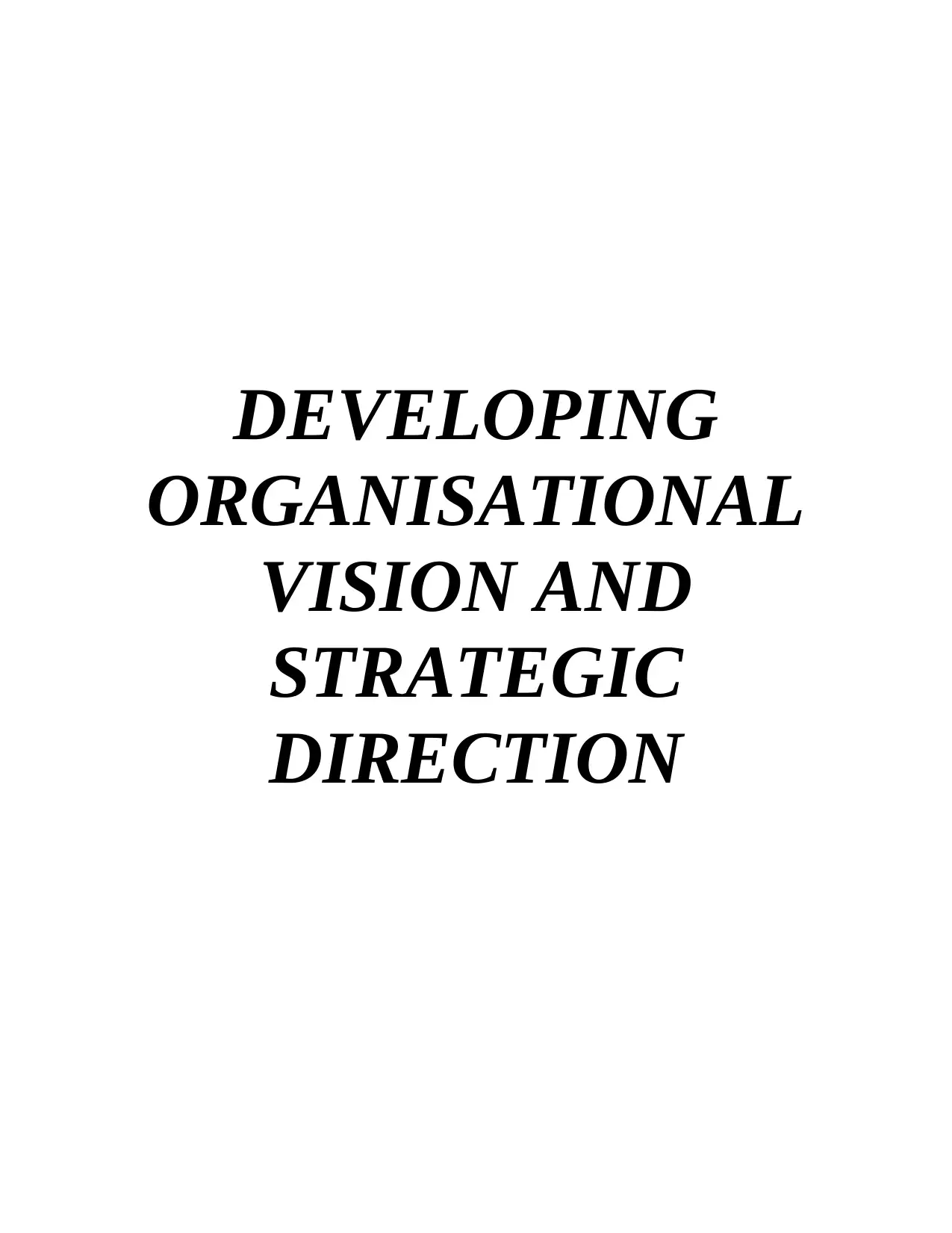
DEVELOPING
ORGANISATIONAL
VISION AND
STRATEGIC
DIRECTION
ORGANISATIONAL
VISION AND
STRATEGIC
DIRECTION
Paraphrase This Document
Need a fresh take? Get an instant paraphrase of this document with our AI Paraphraser
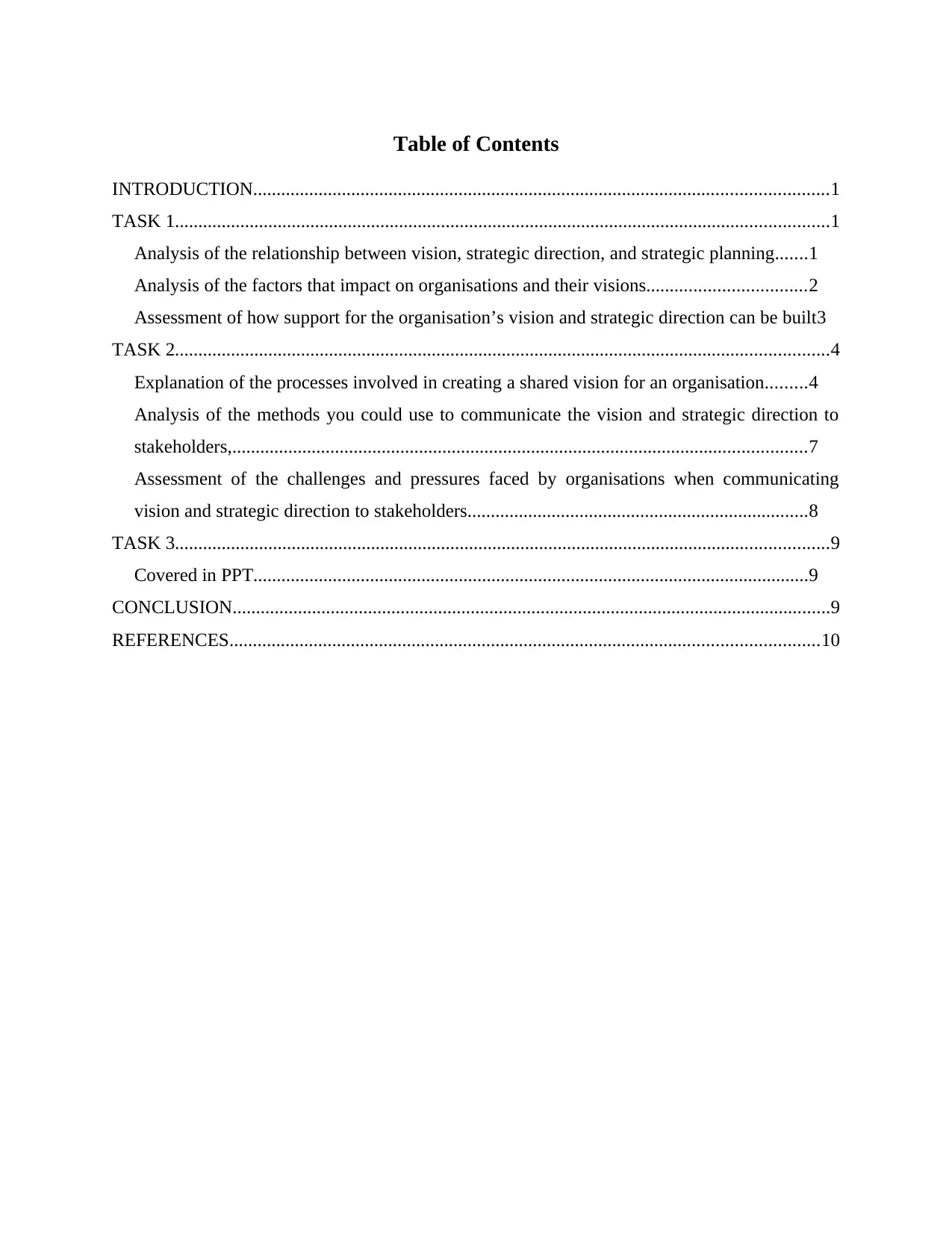
Table of Contents
INTRODUCTION...........................................................................................................................1
TASK 1............................................................................................................................................1
Analysis of the relationship between vision, strategic direction, and strategic planning.......1
Analysis of the factors that impact on organisations and their visions..................................2
Assessment of how support for the organisation’s vision and strategic direction can be built3
TASK 2............................................................................................................................................4
Explanation of the processes involved in creating a shared vision for an organisation.........4
Analysis of the methods you could use to communicate the vision and strategic direction to
stakeholders,...........................................................................................................................7
Assessment of the challenges and pressures faced by organisations when communicating
vision and strategic direction to stakeholders.........................................................................8
TASK 3............................................................................................................................................9
Covered in PPT.......................................................................................................................9
CONCLUSION................................................................................................................................9
REFERENCES..............................................................................................................................10
INTRODUCTION...........................................................................................................................1
TASK 1............................................................................................................................................1
Analysis of the relationship between vision, strategic direction, and strategic planning.......1
Analysis of the factors that impact on organisations and their visions..................................2
Assessment of how support for the organisation’s vision and strategic direction can be built3
TASK 2............................................................................................................................................4
Explanation of the processes involved in creating a shared vision for an organisation.........4
Analysis of the methods you could use to communicate the vision and strategic direction to
stakeholders,...........................................................................................................................7
Assessment of the challenges and pressures faced by organisations when communicating
vision and strategic direction to stakeholders.........................................................................8
TASK 3............................................................................................................................................9
Covered in PPT.......................................................................................................................9
CONCLUSION................................................................................................................................9
REFERENCES..............................................................................................................................10

INTRODUCTION
Vision of an organisation refers to an ultimate goal or objective which the firm is willing
to achieve through its effective operations and functioning. In addition to this, the strategic
direction of an organisation refers to an appropriate and relevant pathway for the company which
provides the firm with a competitive position in the market, along with higher sustainability rate
within the market in which it operates in (Waddell and et. al., 2016). The report below is based
on Coverhill and DataTrack, where the former is responding to an ‘invitation to tender’ (ITT)
document to provide consultancy to DataTrack, an organisation wishing to develop its vision and
associated strategic direction. The report is divided in three tasks where the first task discusses
formation of a written tender document, with emphasis on relationship between vision, strategic
direction and strategic planning of the company as well as analysis of factors impacting
organisations and their visions. Moreover, it also undertakes assessment of how support for the
same could be developed. The second task of the report focuses on process of creating a shared
vision for the organisation, analysis of methods to communicate the same and challenges faced
by the organisation regarding such a vision. The third task covers process for implementing the
vision and strategic direction and analysis of how leadership behaviour promotes the
achievement of the same.
TASK 1
Analysis of the relationship between vision, strategic direction, and strategic planning
It is highly necessary for an organisation to establish an effective relationship between its
vision, strategic direction as well as strategic planning which is being adopted by the firm.
DataTrack is an organisation which expertise in providing online solutions to its customers
within the UK and beyond. Moreover, the organisation deals in providing cloud based managed
services to its service users. However, the firm is quite struggling with formulation of its vision
as well as its strategic direction (Pollack and Pollack, 2015).
For the same, it is highly important that its personal vision and strategic direction is
formulated for the firm to have a consistent and effective objective to work upon as well as a
roadmap to achieve the same. For instance, a proper and effective vision of DataTrack Could be,
“to become the biggest online solution organisation, providing safety, security and reliability to
its customers across the globe with its extraordinary services and consistency”. The arrival
1
Vision of an organisation refers to an ultimate goal or objective which the firm is willing
to achieve through its effective operations and functioning. In addition to this, the strategic
direction of an organisation refers to an appropriate and relevant pathway for the company which
provides the firm with a competitive position in the market, along with higher sustainability rate
within the market in which it operates in (Waddell and et. al., 2016). The report below is based
on Coverhill and DataTrack, where the former is responding to an ‘invitation to tender’ (ITT)
document to provide consultancy to DataTrack, an organisation wishing to develop its vision and
associated strategic direction. The report is divided in three tasks where the first task discusses
formation of a written tender document, with emphasis on relationship between vision, strategic
direction and strategic planning of the company as well as analysis of factors impacting
organisations and their visions. Moreover, it also undertakes assessment of how support for the
same could be developed. The second task of the report focuses on process of creating a shared
vision for the organisation, analysis of methods to communicate the same and challenges faced
by the organisation regarding such a vision. The third task covers process for implementing the
vision and strategic direction and analysis of how leadership behaviour promotes the
achievement of the same.
TASK 1
Analysis of the relationship between vision, strategic direction, and strategic planning
It is highly necessary for an organisation to establish an effective relationship between its
vision, strategic direction as well as strategic planning which is being adopted by the firm.
DataTrack is an organisation which expertise in providing online solutions to its customers
within the UK and beyond. Moreover, the organisation deals in providing cloud based managed
services to its service users. However, the firm is quite struggling with formulation of its vision
as well as its strategic direction (Pollack and Pollack, 2015).
For the same, it is highly important that its personal vision and strategic direction is
formulated for the firm to have a consistent and effective objective to work upon as well as a
roadmap to achieve the same. For instance, a proper and effective vision of DataTrack Could be,
“to become the biggest online solution organisation, providing safety, security and reliability to
its customers across the globe with its extraordinary services and consistency”. The arrival
1
⊘ This is a preview!⊘
Do you want full access?
Subscribe today to unlock all pages.

Trusted by 1+ million students worldwide
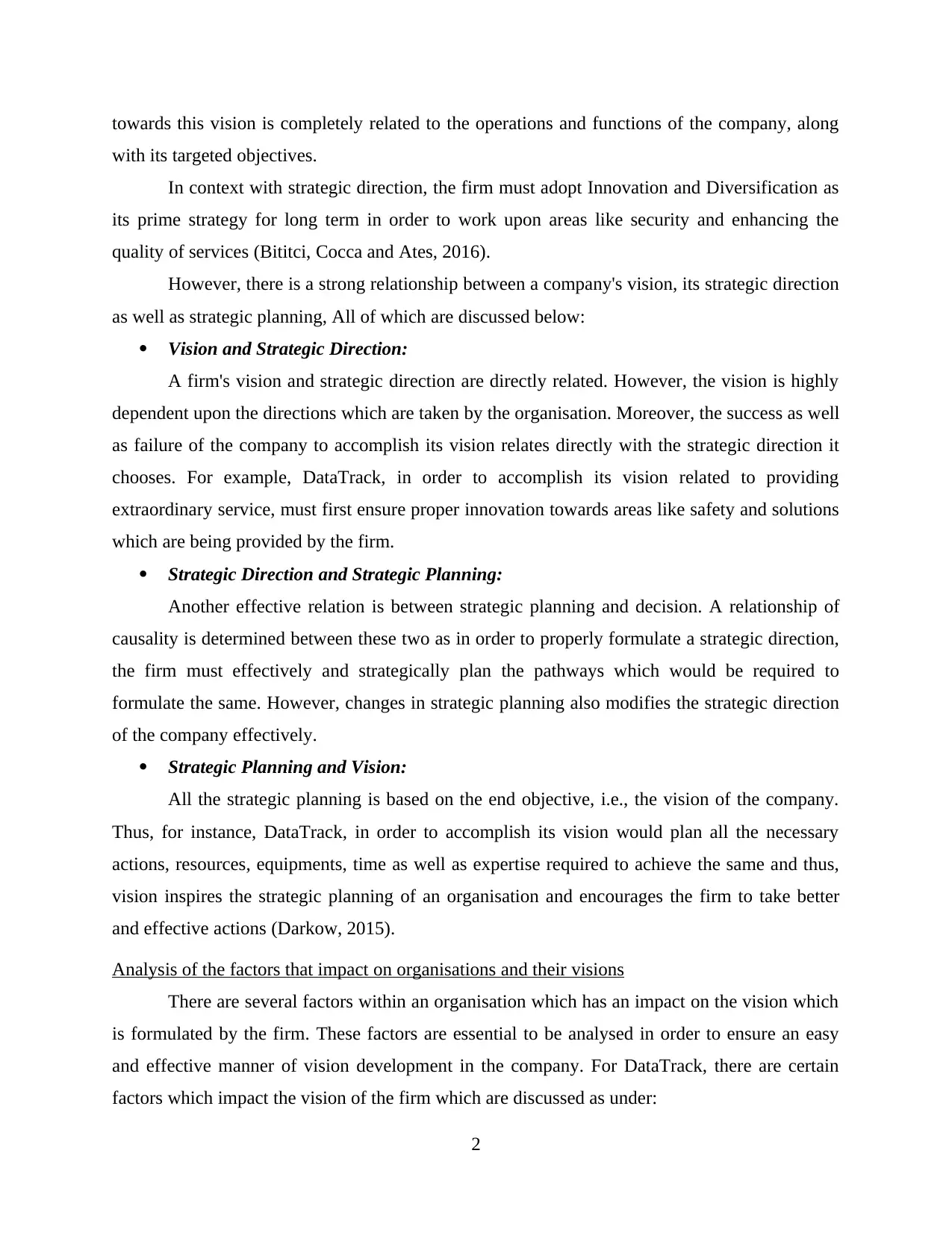
towards this vision is completely related to the operations and functions of the company, along
with its targeted objectives.
In context with strategic direction, the firm must adopt Innovation and Diversification as
its prime strategy for long term in order to work upon areas like security and enhancing the
quality of services (Bititci, Cocca and Ates, 2016).
However, there is a strong relationship between a company's vision, its strategic direction
as well as strategic planning, All of which are discussed below:
Vision and Strategic Direction:
A firm's vision and strategic direction are directly related. However, the vision is highly
dependent upon the directions which are taken by the organisation. Moreover, the success as well
as failure of the company to accomplish its vision relates directly with the strategic direction it
chooses. For example, DataTrack, in order to accomplish its vision related to providing
extraordinary service, must first ensure proper innovation towards areas like safety and solutions
which are being provided by the firm.
Strategic Direction and Strategic Planning:
Another effective relation is between strategic planning and decision. A relationship of
causality is determined between these two as in order to properly formulate a strategic direction,
the firm must effectively and strategically plan the pathways which would be required to
formulate the same. However, changes in strategic planning also modifies the strategic direction
of the company effectively.
Strategic Planning and Vision:
All the strategic planning is based on the end objective, i.e., the vision of the company.
Thus, for instance, DataTrack, in order to accomplish its vision would plan all the necessary
actions, resources, equipments, time as well as expertise required to achieve the same and thus,
vision inspires the strategic planning of an organisation and encourages the firm to take better
and effective actions (Darkow, 2015).
Analysis of the factors that impact on organisations and their visions
There are several factors within an organisation which has an impact on the vision which
is formulated by the firm. These factors are essential to be analysed in order to ensure an easy
and effective manner of vision development in the company. For DataTrack, there are certain
factors which impact the vision of the firm which are discussed as under:
2
with its targeted objectives.
In context with strategic direction, the firm must adopt Innovation and Diversification as
its prime strategy for long term in order to work upon areas like security and enhancing the
quality of services (Bititci, Cocca and Ates, 2016).
However, there is a strong relationship between a company's vision, its strategic direction
as well as strategic planning, All of which are discussed below:
Vision and Strategic Direction:
A firm's vision and strategic direction are directly related. However, the vision is highly
dependent upon the directions which are taken by the organisation. Moreover, the success as well
as failure of the company to accomplish its vision relates directly with the strategic direction it
chooses. For example, DataTrack, in order to accomplish its vision related to providing
extraordinary service, must first ensure proper innovation towards areas like safety and solutions
which are being provided by the firm.
Strategic Direction and Strategic Planning:
Another effective relation is between strategic planning and decision. A relationship of
causality is determined between these two as in order to properly formulate a strategic direction,
the firm must effectively and strategically plan the pathways which would be required to
formulate the same. However, changes in strategic planning also modifies the strategic direction
of the company effectively.
Strategic Planning and Vision:
All the strategic planning is based on the end objective, i.e., the vision of the company.
Thus, for instance, DataTrack, in order to accomplish its vision would plan all the necessary
actions, resources, equipments, time as well as expertise required to achieve the same and thus,
vision inspires the strategic planning of an organisation and encourages the firm to take better
and effective actions (Darkow, 2015).
Analysis of the factors that impact on organisations and their visions
There are several factors within an organisation which has an impact on the vision which
is formulated by the firm. These factors are essential to be analysed in order to ensure an easy
and effective manner of vision development in the company. For DataTrack, there are certain
factors which impact the vision of the firm which are discussed as under:
2
Paraphrase This Document
Need a fresh take? Get an instant paraphrase of this document with our AI Paraphraser
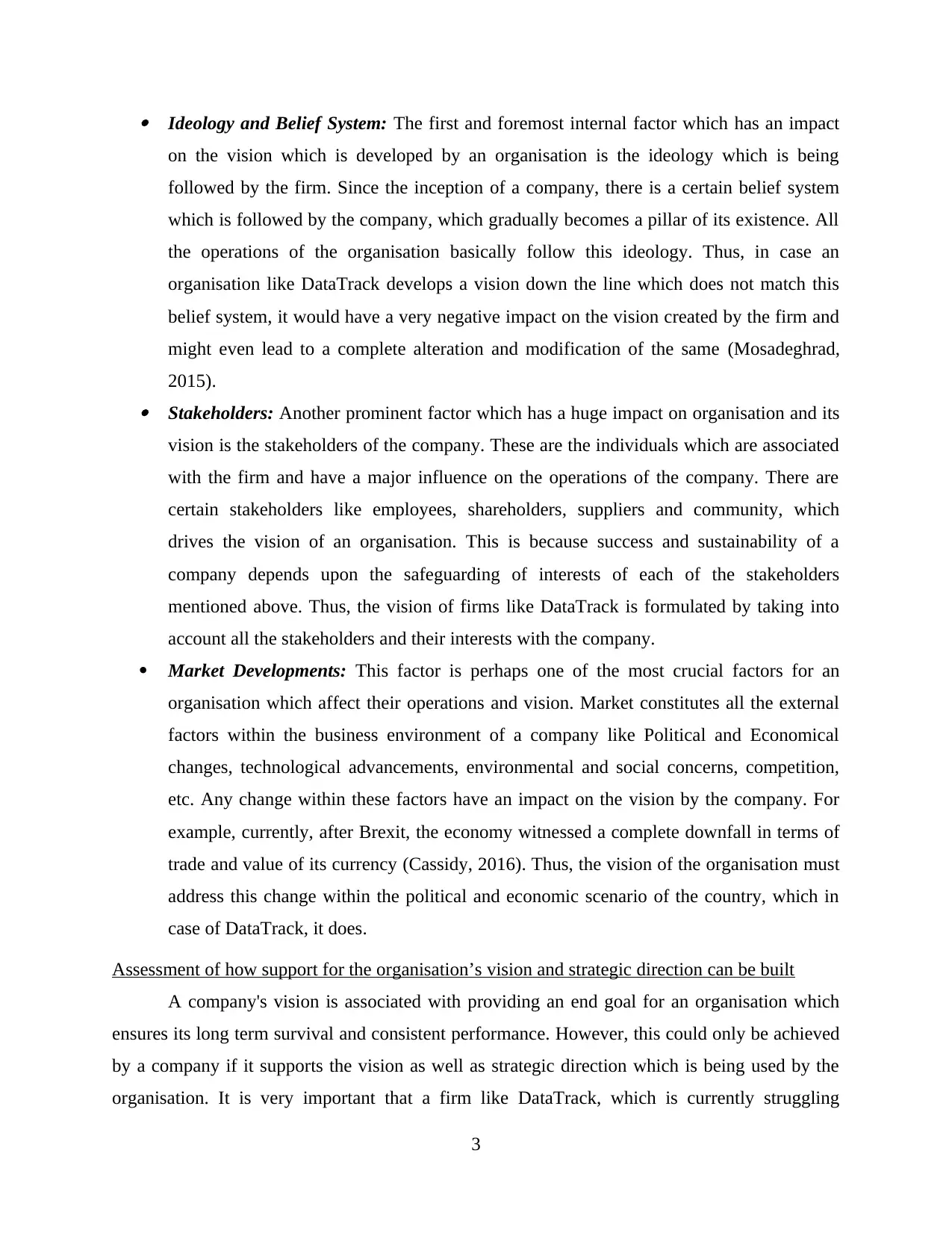
Ideology and Belief System: The first and foremost internal factor which has an impact
on the vision which is developed by an organisation is the ideology which is being
followed by the firm. Since the inception of a company, there is a certain belief system
which is followed by the company, which gradually becomes a pillar of its existence. All
the operations of the organisation basically follow this ideology. Thus, in case an
organisation like DataTrack develops a vision down the line which does not match this
belief system, it would have a very negative impact on the vision created by the firm and
might even lead to a complete alteration and modification of the same (Mosadeghrad,
2015). Stakeholders: Another prominent factor which has a huge impact on organisation and its
vision is the stakeholders of the company. These are the individuals which are associated
with the firm and have a major influence on the operations of the company. There are
certain stakeholders like employees, shareholders, suppliers and community, which
drives the vision of an organisation. This is because success and sustainability of a
company depends upon the safeguarding of interests of each of the stakeholders
mentioned above. Thus, the vision of firms like DataTrack is formulated by taking into
account all the stakeholders and their interests with the company.
Market Developments: This factor is perhaps one of the most crucial factors for an
organisation which affect their operations and vision. Market constitutes all the external
factors within the business environment of a company like Political and Economical
changes, technological advancements, environmental and social concerns, competition,
etc. Any change within these factors have an impact on the vision by the company. For
example, currently, after Brexit, the economy witnessed a complete downfall in terms of
trade and value of its currency (Cassidy, 2016). Thus, the vision of the organisation must
address this change within the political and economic scenario of the country, which in
case of DataTrack, it does.
Assessment of how support for the organisation’s vision and strategic direction can be built
A company's vision is associated with providing an end goal for an organisation which
ensures its long term survival and consistent performance. However, this could only be achieved
by a company if it supports the vision as well as strategic direction which is being used by the
organisation. It is very important that a firm like DataTrack, which is currently struggling
3
on the vision which is developed by an organisation is the ideology which is being
followed by the firm. Since the inception of a company, there is a certain belief system
which is followed by the company, which gradually becomes a pillar of its existence. All
the operations of the organisation basically follow this ideology. Thus, in case an
organisation like DataTrack develops a vision down the line which does not match this
belief system, it would have a very negative impact on the vision created by the firm and
might even lead to a complete alteration and modification of the same (Mosadeghrad,
2015). Stakeholders: Another prominent factor which has a huge impact on organisation and its
vision is the stakeholders of the company. These are the individuals which are associated
with the firm and have a major influence on the operations of the company. There are
certain stakeholders like employees, shareholders, suppliers and community, which
drives the vision of an organisation. This is because success and sustainability of a
company depends upon the safeguarding of interests of each of the stakeholders
mentioned above. Thus, the vision of firms like DataTrack is formulated by taking into
account all the stakeholders and their interests with the company.
Market Developments: This factor is perhaps one of the most crucial factors for an
organisation which affect their operations and vision. Market constitutes all the external
factors within the business environment of a company like Political and Economical
changes, technological advancements, environmental and social concerns, competition,
etc. Any change within these factors have an impact on the vision by the company. For
example, currently, after Brexit, the economy witnessed a complete downfall in terms of
trade and value of its currency (Cassidy, 2016). Thus, the vision of the organisation must
address this change within the political and economic scenario of the country, which in
case of DataTrack, it does.
Assessment of how support for the organisation’s vision and strategic direction can be built
A company's vision is associated with providing an end goal for an organisation which
ensures its long term survival and consistent performance. However, this could only be achieved
by a company if it supports the vision as well as strategic direction which is being used by the
organisation. It is very important that a firm like DataTrack, which is currently struggling
3
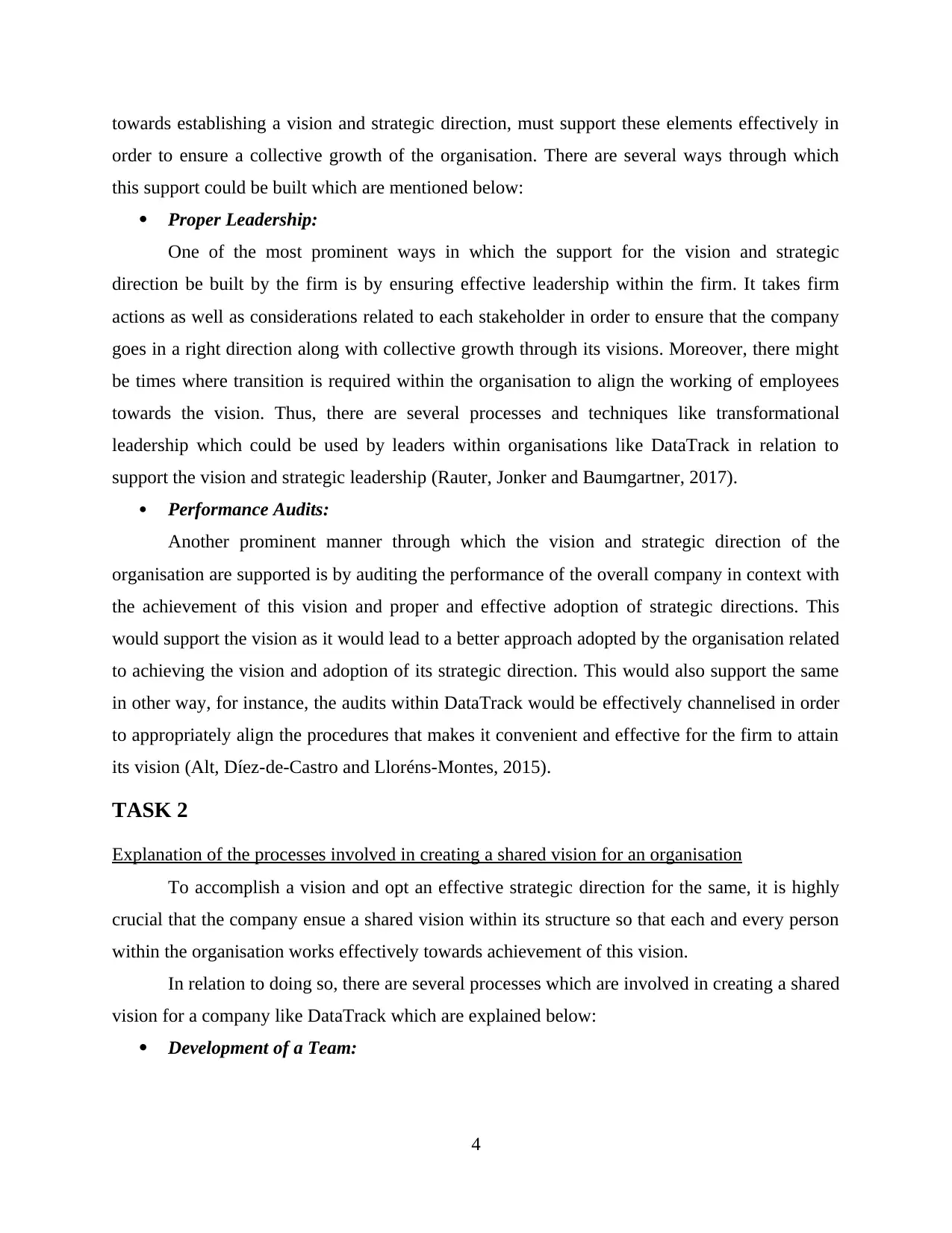
towards establishing a vision and strategic direction, must support these elements effectively in
order to ensure a collective growth of the organisation. There are several ways through which
this support could be built which are mentioned below:
Proper Leadership:
One of the most prominent ways in which the support for the vision and strategic
direction be built by the firm is by ensuring effective leadership within the firm. It takes firm
actions as well as considerations related to each stakeholder in order to ensure that the company
goes in a right direction along with collective growth through its visions. Moreover, there might
be times where transition is required within the organisation to align the working of employees
towards the vision. Thus, there are several processes and techniques like transformational
leadership which could be used by leaders within organisations like DataTrack in relation to
support the vision and strategic leadership (Rauter, Jonker and Baumgartner, 2017).
Performance Audits:
Another prominent manner through which the vision and strategic direction of the
organisation are supported is by auditing the performance of the overall company in context with
the achievement of this vision and proper and effective adoption of strategic directions. This
would support the vision as it would lead to a better approach adopted by the organisation related
to achieving the vision and adoption of its strategic direction. This would also support the same
in other way, for instance, the audits within DataTrack would be effectively channelised in order
to appropriately align the procedures that makes it convenient and effective for the firm to attain
its vision (Alt, Díez-de-Castro and Lloréns-Montes, 2015).
TASK 2
Explanation of the processes involved in creating a shared vision for an organisation
To accomplish a vision and opt an effective strategic direction for the same, it is highly
crucial that the company ensue a shared vision within its structure so that each and every person
within the organisation works effectively towards achievement of this vision.
In relation to doing so, there are several processes which are involved in creating a shared
vision for a company like DataTrack which are explained below:
Development of a Team:
4
order to ensure a collective growth of the organisation. There are several ways through which
this support could be built which are mentioned below:
Proper Leadership:
One of the most prominent ways in which the support for the vision and strategic
direction be built by the firm is by ensuring effective leadership within the firm. It takes firm
actions as well as considerations related to each stakeholder in order to ensure that the company
goes in a right direction along with collective growth through its visions. Moreover, there might
be times where transition is required within the organisation to align the working of employees
towards the vision. Thus, there are several processes and techniques like transformational
leadership which could be used by leaders within organisations like DataTrack in relation to
support the vision and strategic leadership (Rauter, Jonker and Baumgartner, 2017).
Performance Audits:
Another prominent manner through which the vision and strategic direction of the
organisation are supported is by auditing the performance of the overall company in context with
the achievement of this vision and proper and effective adoption of strategic directions. This
would support the vision as it would lead to a better approach adopted by the organisation related
to achieving the vision and adoption of its strategic direction. This would also support the same
in other way, for instance, the audits within DataTrack would be effectively channelised in order
to appropriately align the procedures that makes it convenient and effective for the firm to attain
its vision (Alt, Díez-de-Castro and Lloréns-Montes, 2015).
TASK 2
Explanation of the processes involved in creating a shared vision for an organisation
To accomplish a vision and opt an effective strategic direction for the same, it is highly
crucial that the company ensue a shared vision within its structure so that each and every person
within the organisation works effectively towards achievement of this vision.
In relation to doing so, there are several processes which are involved in creating a shared
vision for a company like DataTrack which are explained below:
Development of a Team:
4
⊘ This is a preview!⊘
Do you want full access?
Subscribe today to unlock all pages.

Trusted by 1+ million students worldwide
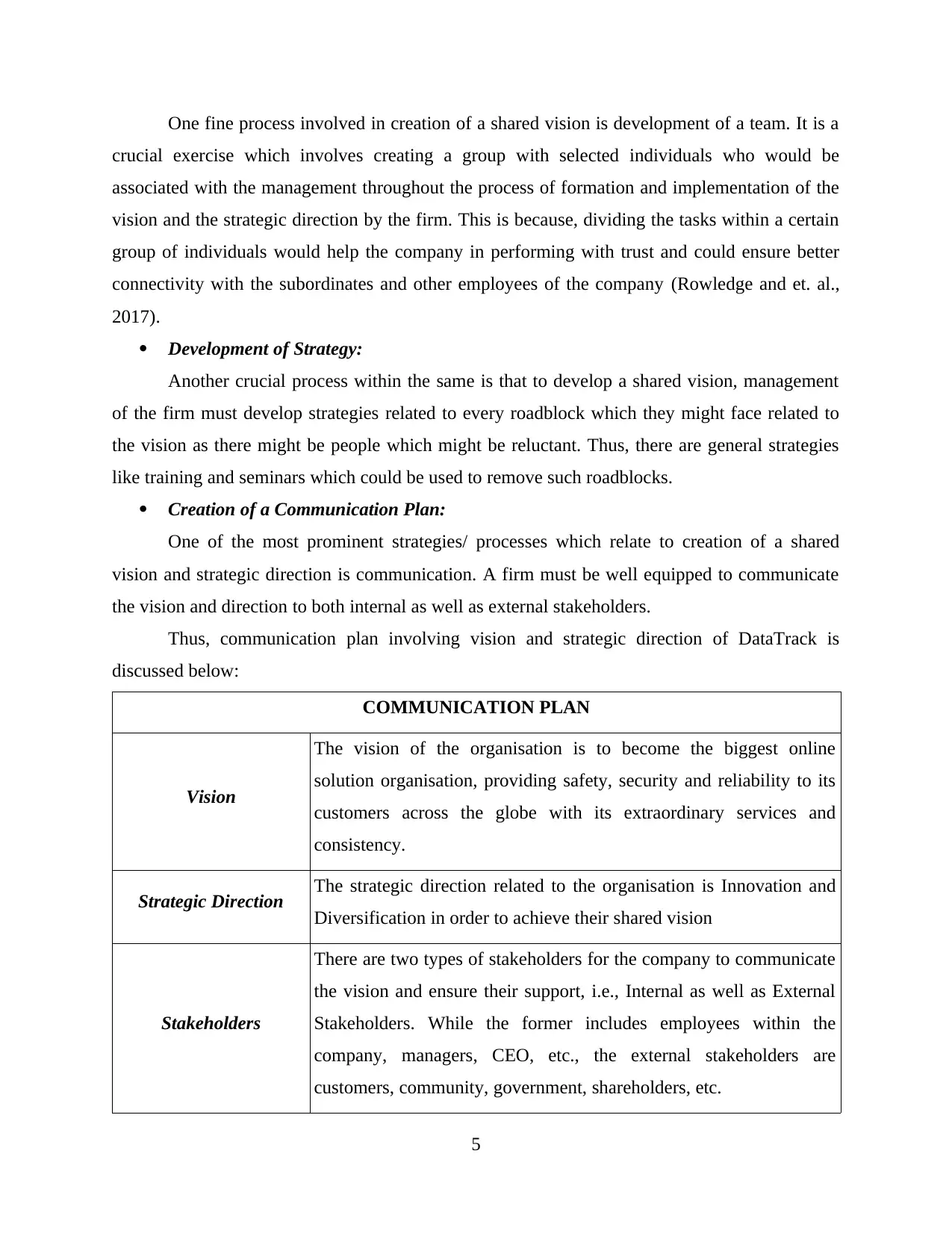
One fine process involved in creation of a shared vision is development of a team. It is a
crucial exercise which involves creating a group with selected individuals who would be
associated with the management throughout the process of formation and implementation of the
vision and the strategic direction by the firm. This is because, dividing the tasks within a certain
group of individuals would help the company in performing with trust and could ensure better
connectivity with the subordinates and other employees of the company (Rowledge and et. al.,
2017).
Development of Strategy:
Another crucial process within the same is that to develop a shared vision, management
of the firm must develop strategies related to every roadblock which they might face related to
the vision as there might be people which might be reluctant. Thus, there are general strategies
like training and seminars which could be used to remove such roadblocks.
Creation of a Communication Plan:
One of the most prominent strategies/ processes which relate to creation of a shared
vision and strategic direction is communication. A firm must be well equipped to communicate
the vision and direction to both internal as well as external stakeholders.
Thus, communication plan involving vision and strategic direction of DataTrack is
discussed below:
COMMUNICATION PLAN
Vision
The vision of the organisation is to become the biggest online
solution organisation, providing safety, security and reliability to its
customers across the globe with its extraordinary services and
consistency.
Strategic Direction The strategic direction related to the organisation is Innovation and
Diversification in order to achieve their shared vision
Stakeholders
There are two types of stakeholders for the company to communicate
the vision and ensure their support, i.e., Internal as well as External
Stakeholders. While the former includes employees within the
company, managers, CEO, etc., the external stakeholders are
customers, community, government, shareholders, etc.
5
crucial exercise which involves creating a group with selected individuals who would be
associated with the management throughout the process of formation and implementation of the
vision and the strategic direction by the firm. This is because, dividing the tasks within a certain
group of individuals would help the company in performing with trust and could ensure better
connectivity with the subordinates and other employees of the company (Rowledge and et. al.,
2017).
Development of Strategy:
Another crucial process within the same is that to develop a shared vision, management
of the firm must develop strategies related to every roadblock which they might face related to
the vision as there might be people which might be reluctant. Thus, there are general strategies
like training and seminars which could be used to remove such roadblocks.
Creation of a Communication Plan:
One of the most prominent strategies/ processes which relate to creation of a shared
vision and strategic direction is communication. A firm must be well equipped to communicate
the vision and direction to both internal as well as external stakeholders.
Thus, communication plan involving vision and strategic direction of DataTrack is
discussed below:
COMMUNICATION PLAN
Vision
The vision of the organisation is to become the biggest online
solution organisation, providing safety, security and reliability to its
customers across the globe with its extraordinary services and
consistency.
Strategic Direction The strategic direction related to the organisation is Innovation and
Diversification in order to achieve their shared vision
Stakeholders
There are two types of stakeholders for the company to communicate
the vision and ensure their support, i.e., Internal as well as External
Stakeholders. While the former includes employees within the
company, managers, CEO, etc., the external stakeholders are
customers, community, government, shareholders, etc.
5
Paraphrase This Document
Need a fresh take? Get an instant paraphrase of this document with our AI Paraphraser
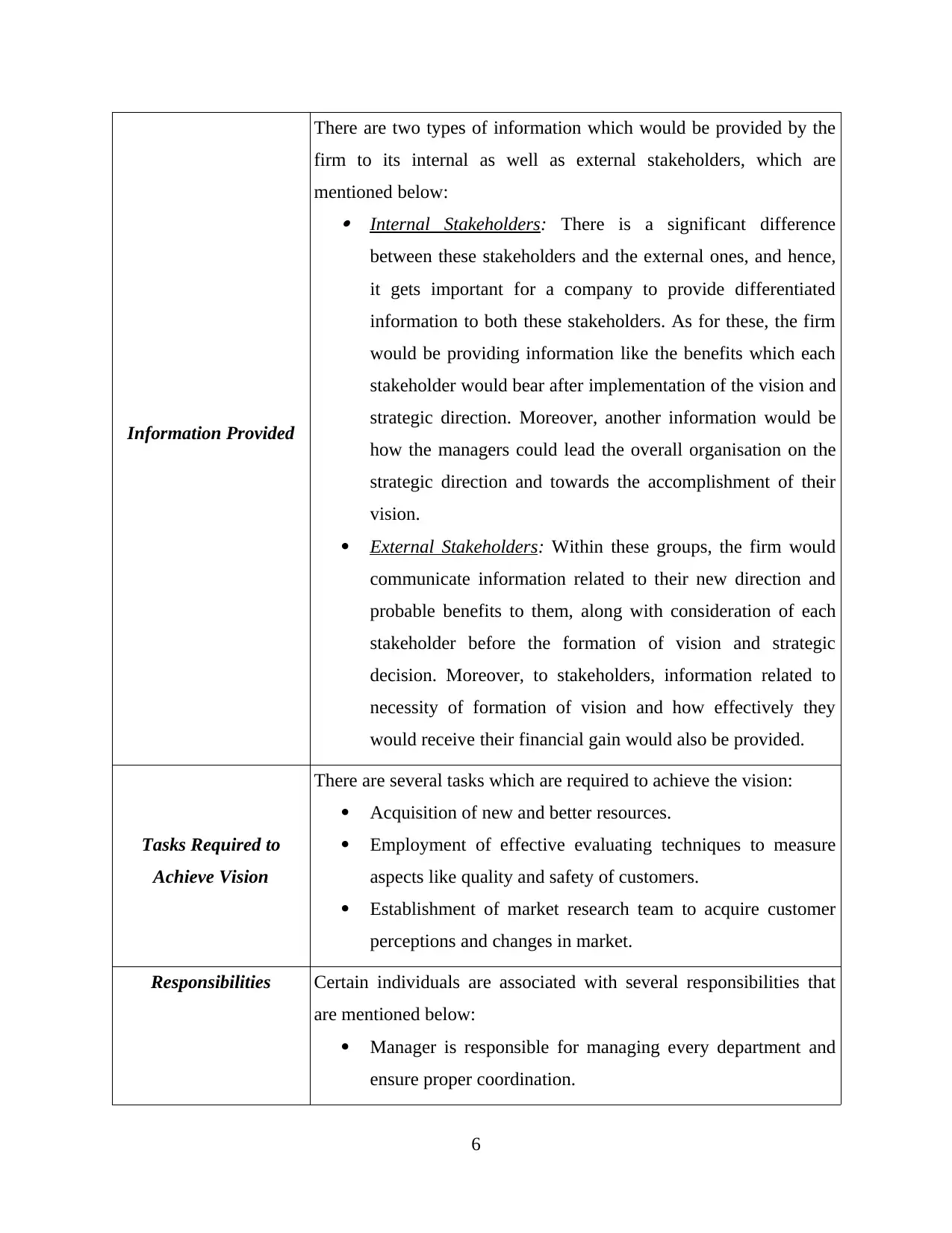
Information Provided
There are two types of information which would be provided by the
firm to its internal as well as external stakeholders, which are
mentioned below:
Internal Stakeholders: There is a significant difference
between these stakeholders and the external ones, and hence,
it gets important for a company to provide differentiated
information to both these stakeholders. As for these, the firm
would be providing information like the benefits which each
stakeholder would bear after implementation of the vision and
strategic direction. Moreover, another information would be
how the managers could lead the overall organisation on the
strategic direction and towards the accomplishment of their
vision.
External Stakeholders: Within these groups, the firm would
communicate information related to their new direction and
probable benefits to them, along with consideration of each
stakeholder before the formation of vision and strategic
decision. Moreover, to stakeholders, information related to
necessity of formation of vision and how effectively they
would receive their financial gain would also be provided.
Tasks Required to
Achieve Vision
There are several tasks which are required to achieve the vision:
Acquisition of new and better resources.
Employment of effective evaluating techniques to measure
aspects like quality and safety of customers.
Establishment of market research team to acquire customer
perceptions and changes in market.
Responsibilities Certain individuals are associated with several responsibilities that
are mentioned below:
Manager is responsible for managing every department and
ensure proper coordination.
6
There are two types of information which would be provided by the
firm to its internal as well as external stakeholders, which are
mentioned below:
Internal Stakeholders: There is a significant difference
between these stakeholders and the external ones, and hence,
it gets important for a company to provide differentiated
information to both these stakeholders. As for these, the firm
would be providing information like the benefits which each
stakeholder would bear after implementation of the vision and
strategic direction. Moreover, another information would be
how the managers could lead the overall organisation on the
strategic direction and towards the accomplishment of their
vision.
External Stakeholders: Within these groups, the firm would
communicate information related to their new direction and
probable benefits to them, along with consideration of each
stakeholder before the formation of vision and strategic
decision. Moreover, to stakeholders, information related to
necessity of formation of vision and how effectively they
would receive their financial gain would also be provided.
Tasks Required to
Achieve Vision
There are several tasks which are required to achieve the vision:
Acquisition of new and better resources.
Employment of effective evaluating techniques to measure
aspects like quality and safety of customers.
Establishment of market research team to acquire customer
perceptions and changes in market.
Responsibilities Certain individuals are associated with several responsibilities that
are mentioned below:
Manager is responsible for managing every department and
ensure proper coordination.
6
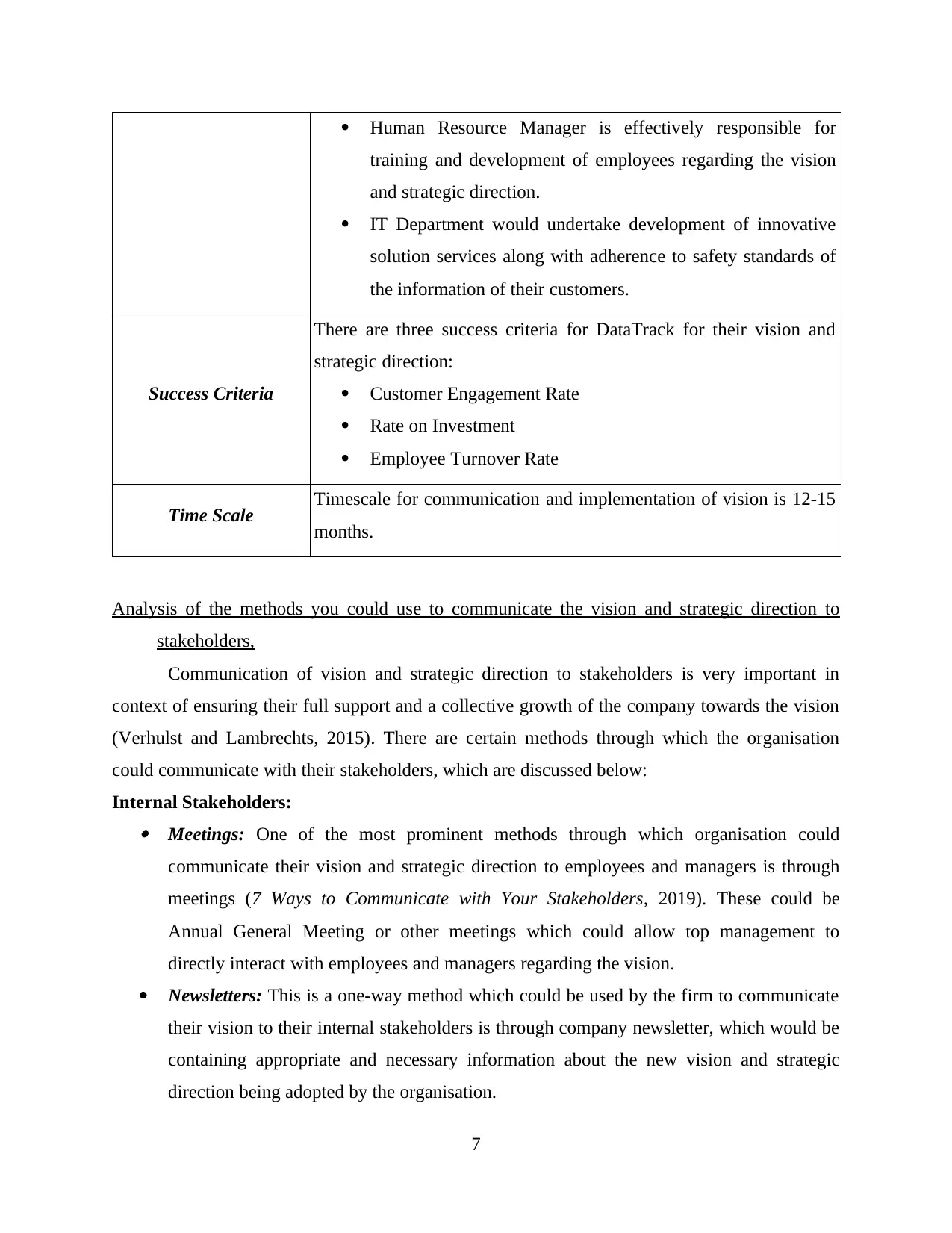
Human Resource Manager is effectively responsible for
training and development of employees regarding the vision
and strategic direction.
IT Department would undertake development of innovative
solution services along with adherence to safety standards of
the information of their customers.
Success Criteria
There are three success criteria for DataTrack for their vision and
strategic direction:
Customer Engagement Rate
Rate on Investment
Employee Turnover Rate
Time Scale Timescale for communication and implementation of vision is 12-15
months.
Analysis of the methods you could use to communicate the vision and strategic direction to
stakeholders,
Communication of vision and strategic direction to stakeholders is very important in
context of ensuring their full support and a collective growth of the company towards the vision
(Verhulst and Lambrechts, 2015). There are certain methods through which the organisation
could communicate with their stakeholders, which are discussed below:
Internal Stakeholders: Meetings: One of the most prominent methods through which organisation could
communicate their vision and strategic direction to employees and managers is through
meetings (7 Ways to Communicate with Your Stakeholders, 2019). These could be
Annual General Meeting or other meetings which could allow top management to
directly interact with employees and managers regarding the vision.
Newsletters: This is a one-way method which could be used by the firm to communicate
their vision to their internal stakeholders is through company newsletter, which would be
containing appropriate and necessary information about the new vision and strategic
direction being adopted by the organisation.
7
training and development of employees regarding the vision
and strategic direction.
IT Department would undertake development of innovative
solution services along with adherence to safety standards of
the information of their customers.
Success Criteria
There are three success criteria for DataTrack for their vision and
strategic direction:
Customer Engagement Rate
Rate on Investment
Employee Turnover Rate
Time Scale Timescale for communication and implementation of vision is 12-15
months.
Analysis of the methods you could use to communicate the vision and strategic direction to
stakeholders,
Communication of vision and strategic direction to stakeholders is very important in
context of ensuring their full support and a collective growth of the company towards the vision
(Verhulst and Lambrechts, 2015). There are certain methods through which the organisation
could communicate with their stakeholders, which are discussed below:
Internal Stakeholders: Meetings: One of the most prominent methods through which organisation could
communicate their vision and strategic direction to employees and managers is through
meetings (7 Ways to Communicate with Your Stakeholders, 2019). These could be
Annual General Meeting or other meetings which could allow top management to
directly interact with employees and managers regarding the vision.
Newsletters: This is a one-way method which could be used by the firm to communicate
their vision to their internal stakeholders is through company newsletter, which would be
containing appropriate and necessary information about the new vision and strategic
direction being adopted by the organisation.
7
⊘ This is a preview!⊘
Do you want full access?
Subscribe today to unlock all pages.

Trusted by 1+ million students worldwide
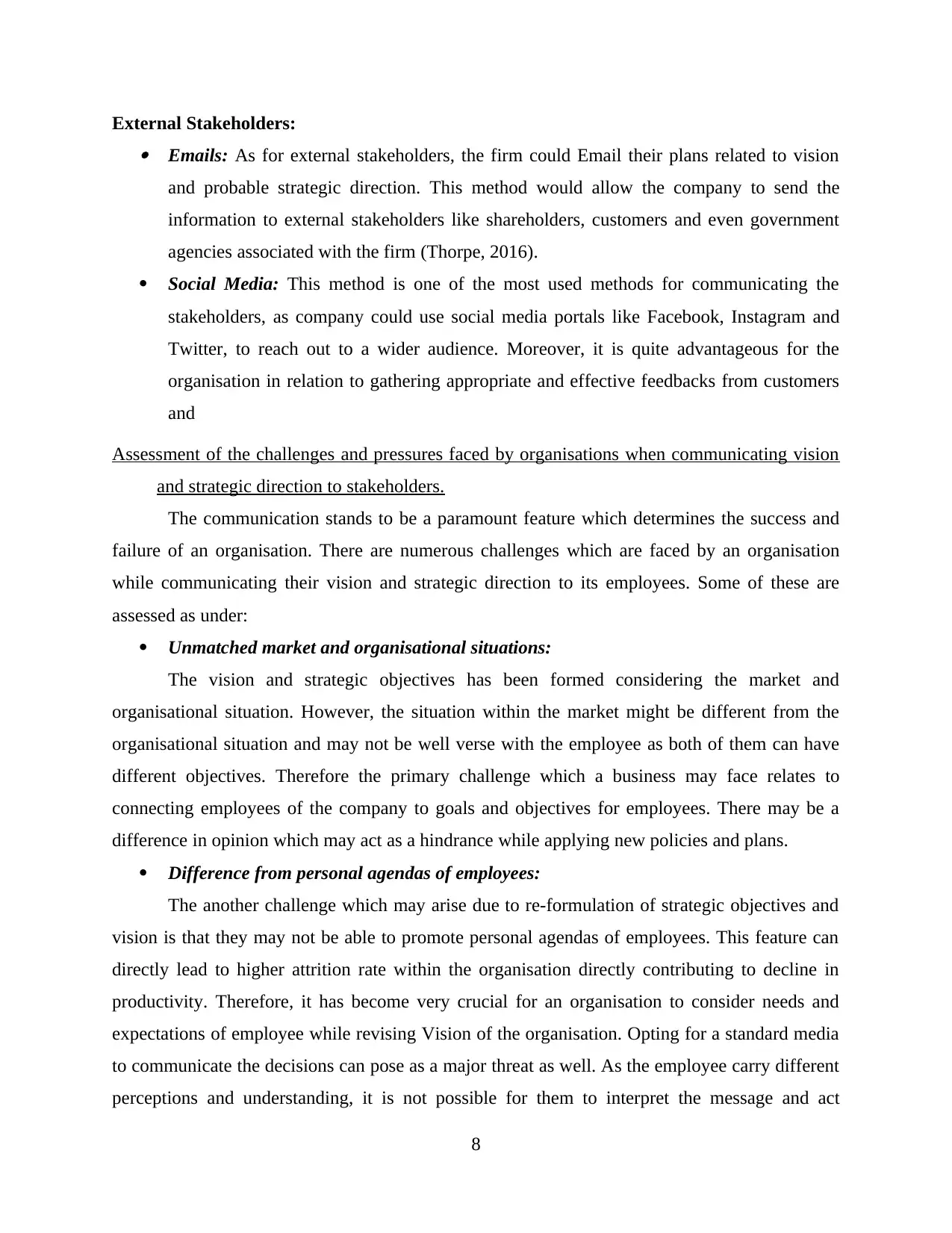
External Stakeholders: Emails: As for external stakeholders, the firm could Email their plans related to vision
and probable strategic direction. This method would allow the company to send the
information to external stakeholders like shareholders, customers and even government
agencies associated with the firm (Thorpe, 2016).
Social Media: This method is one of the most used methods for communicating the
stakeholders, as company could use social media portals like Facebook, Instagram and
Twitter, to reach out to a wider audience. Moreover, it is quite advantageous for the
organisation in relation to gathering appropriate and effective feedbacks from customers
and
Assessment of the challenges and pressures faced by organisations when communicating vision
and strategic direction to stakeholders.
The communication stands to be a paramount feature which determines the success and
failure of an organisation. There are numerous challenges which are faced by an organisation
while communicating their vision and strategic direction to its employees. Some of these are
assessed as under:
Unmatched market and organisational situations:
The vision and strategic objectives has been formed considering the market and
organisational situation. However, the situation within the market might be different from the
organisational situation and may not be well verse with the employee as both of them can have
different objectives. Therefore the primary challenge which a business may face relates to
connecting employees of the company to goals and objectives for employees. There may be a
difference in opinion which may act as a hindrance while applying new policies and plans.
Difference from personal agendas of employees:
The another challenge which may arise due to re-formulation of strategic objectives and
vision is that they may not be able to promote personal agendas of employees. This feature can
directly lead to higher attrition rate within the organisation directly contributing to decline in
productivity. Therefore, it has become very crucial for an organisation to consider needs and
expectations of employee while revising Vision of the organisation. Opting for a standard media
to communicate the decisions can pose as a major threat as well. As the employee carry different
perceptions and understanding, it is not possible for them to interpret the message and act
8
and probable strategic direction. This method would allow the company to send the
information to external stakeholders like shareholders, customers and even government
agencies associated with the firm (Thorpe, 2016).
Social Media: This method is one of the most used methods for communicating the
stakeholders, as company could use social media portals like Facebook, Instagram and
Twitter, to reach out to a wider audience. Moreover, it is quite advantageous for the
organisation in relation to gathering appropriate and effective feedbacks from customers
and
Assessment of the challenges and pressures faced by organisations when communicating vision
and strategic direction to stakeholders.
The communication stands to be a paramount feature which determines the success and
failure of an organisation. There are numerous challenges which are faced by an organisation
while communicating their vision and strategic direction to its employees. Some of these are
assessed as under:
Unmatched market and organisational situations:
The vision and strategic objectives has been formed considering the market and
organisational situation. However, the situation within the market might be different from the
organisational situation and may not be well verse with the employee as both of them can have
different objectives. Therefore the primary challenge which a business may face relates to
connecting employees of the company to goals and objectives for employees. There may be a
difference in opinion which may act as a hindrance while applying new policies and plans.
Difference from personal agendas of employees:
The another challenge which may arise due to re-formulation of strategic objectives and
vision is that they may not be able to promote personal agendas of employees. This feature can
directly lead to higher attrition rate within the organisation directly contributing to decline in
productivity. Therefore, it has become very crucial for an organisation to consider needs and
expectations of employee while revising Vision of the organisation. Opting for a standard media
to communicate the decisions can pose as a major threat as well. As the employee carry different
perceptions and understanding, it is not possible for them to interpret the message and act
8
Paraphrase This Document
Need a fresh take? Get an instant paraphrase of this document with our AI Paraphraser
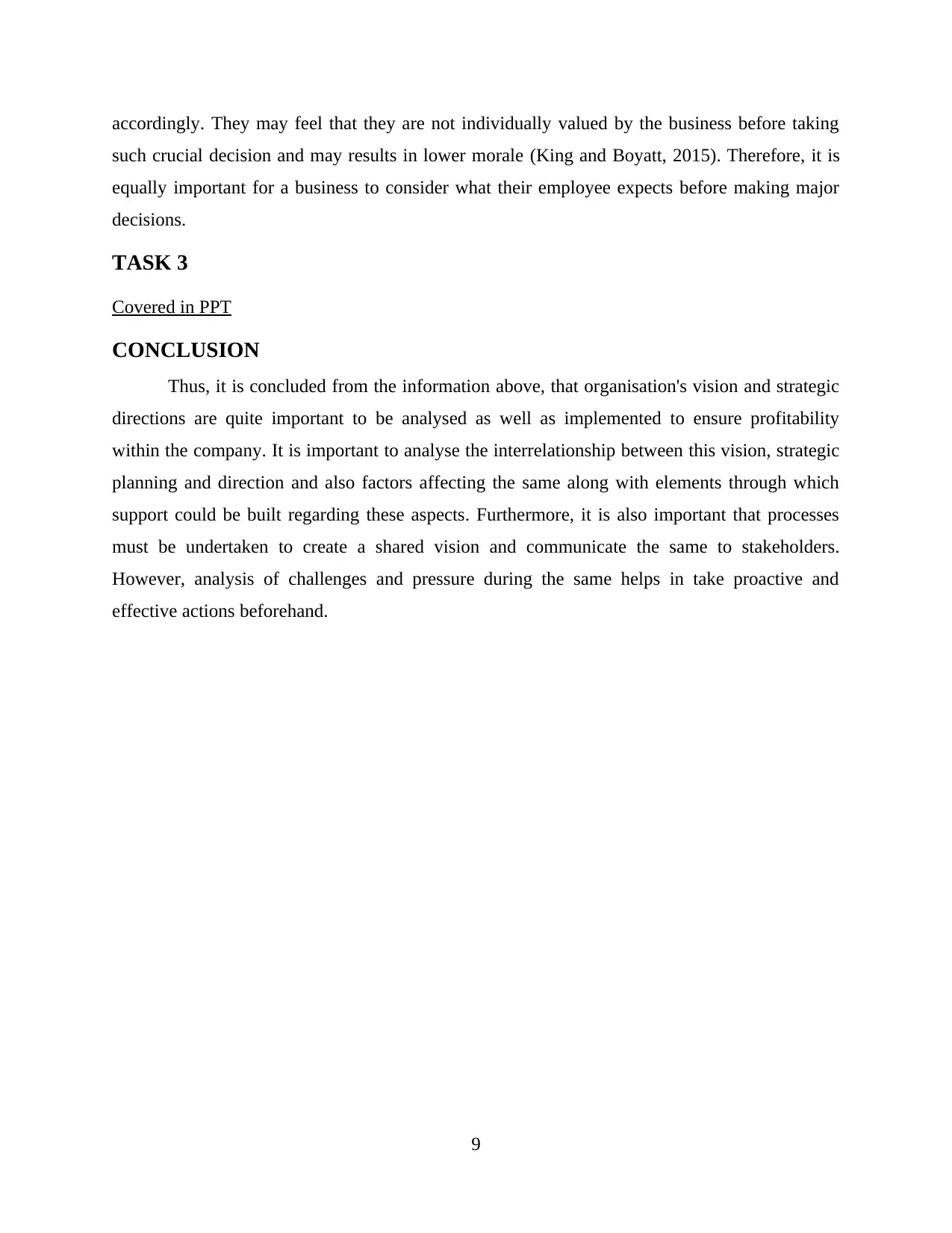
accordingly. They may feel that they are not individually valued by the business before taking
such crucial decision and may results in lower morale (King and Boyatt, 2015). Therefore, it is
equally important for a business to consider what their employee expects before making major
decisions.
TASK 3
Covered in PPT
CONCLUSION
Thus, it is concluded from the information above, that organisation's vision and strategic
directions are quite important to be analysed as well as implemented to ensure profitability
within the company. It is important to analyse the interrelationship between this vision, strategic
planning and direction and also factors affecting the same along with elements through which
support could be built regarding these aspects. Furthermore, it is also important that processes
must be undertaken to create a shared vision and communicate the same to stakeholders.
However, analysis of challenges and pressure during the same helps in take proactive and
effective actions beforehand.
9
such crucial decision and may results in lower morale (King and Boyatt, 2015). Therefore, it is
equally important for a business to consider what their employee expects before making major
decisions.
TASK 3
Covered in PPT
CONCLUSION
Thus, it is concluded from the information above, that organisation's vision and strategic
directions are quite important to be analysed as well as implemented to ensure profitability
within the company. It is important to analyse the interrelationship between this vision, strategic
planning and direction and also factors affecting the same along with elements through which
support could be built regarding these aspects. Furthermore, it is also important that processes
must be undertaken to create a shared vision and communicate the same to stakeholders.
However, analysis of challenges and pressure during the same helps in take proactive and
effective actions beforehand.
9
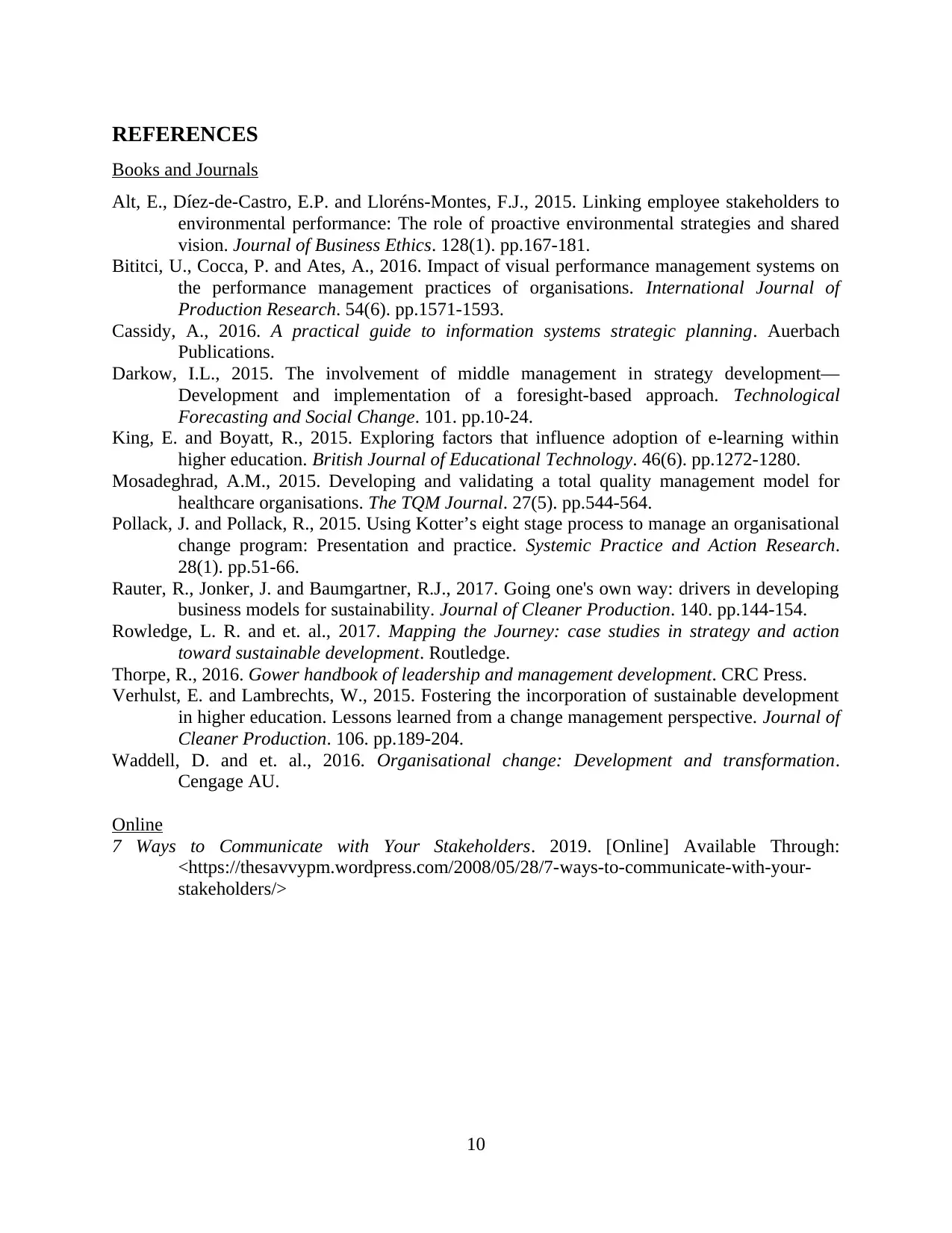
REFERENCES
Books and Journals
Alt, E., Díez-de-Castro, E.P. and Lloréns-Montes, F.J., 2015. Linking employee stakeholders to
environmental performance: The role of proactive environmental strategies and shared
vision. Journal of Business Ethics. 128(1). pp.167-181.
Bititci, U., Cocca, P. and Ates, A., 2016. Impact of visual performance management systems on
the performance management practices of organisations. International Journal of
Production Research. 54(6). pp.1571-1593.
Cassidy, A., 2016. A practical guide to information systems strategic planning. Auerbach
Publications.
Darkow, I.L., 2015. The involvement of middle management in strategy development—
Development and implementation of a foresight-based approach. Technological
Forecasting and Social Change. 101. pp.10-24.
King, E. and Boyatt, R., 2015. Exploring factors that influence adoption of e‐learning within
higher education. British Journal of Educational Technology. 46(6). pp.1272-1280.
Mosadeghrad, A.M., 2015. Developing and validating a total quality management model for
healthcare organisations. The TQM Journal. 27(5). pp.544-564.
Pollack, J. and Pollack, R., 2015. Using Kotter’s eight stage process to manage an organisational
change program: Presentation and practice. Systemic Practice and Action Research.
28(1). pp.51-66.
Rauter, R., Jonker, J. and Baumgartner, R.J., 2017. Going one's own way: drivers in developing
business models for sustainability. Journal of Cleaner Production. 140. pp.144-154.
Rowledge, L. R. and et. al., 2017. Mapping the Journey: case studies in strategy and action
toward sustainable development. Routledge.
Thorpe, R., 2016. Gower handbook of leadership and management development. CRC Press.
Verhulst, E. and Lambrechts, W., 2015. Fostering the incorporation of sustainable development
in higher education. Lessons learned from a change management perspective. Journal of
Cleaner Production. 106. pp.189-204.
Waddell, D. and et. al., 2016. Organisational change: Development and transformation.
Cengage AU.
Online
7 Ways to Communicate with Your Stakeholders. 2019. [Online] Available Through:
<https://thesavvypm.wordpress.com/2008/05/28/7-ways-to-communicate-with-your-
stakeholders/>
10
Books and Journals
Alt, E., Díez-de-Castro, E.P. and Lloréns-Montes, F.J., 2015. Linking employee stakeholders to
environmental performance: The role of proactive environmental strategies and shared
vision. Journal of Business Ethics. 128(1). pp.167-181.
Bititci, U., Cocca, P. and Ates, A., 2016. Impact of visual performance management systems on
the performance management practices of organisations. International Journal of
Production Research. 54(6). pp.1571-1593.
Cassidy, A., 2016. A practical guide to information systems strategic planning. Auerbach
Publications.
Darkow, I.L., 2015. The involvement of middle management in strategy development—
Development and implementation of a foresight-based approach. Technological
Forecasting and Social Change. 101. pp.10-24.
King, E. and Boyatt, R., 2015. Exploring factors that influence adoption of e‐learning within
higher education. British Journal of Educational Technology. 46(6). pp.1272-1280.
Mosadeghrad, A.M., 2015. Developing and validating a total quality management model for
healthcare organisations. The TQM Journal. 27(5). pp.544-564.
Pollack, J. and Pollack, R., 2015. Using Kotter’s eight stage process to manage an organisational
change program: Presentation and practice. Systemic Practice and Action Research.
28(1). pp.51-66.
Rauter, R., Jonker, J. and Baumgartner, R.J., 2017. Going one's own way: drivers in developing
business models for sustainability. Journal of Cleaner Production. 140. pp.144-154.
Rowledge, L. R. and et. al., 2017. Mapping the Journey: case studies in strategy and action
toward sustainable development. Routledge.
Thorpe, R., 2016. Gower handbook of leadership and management development. CRC Press.
Verhulst, E. and Lambrechts, W., 2015. Fostering the incorporation of sustainable development
in higher education. Lessons learned from a change management perspective. Journal of
Cleaner Production. 106. pp.189-204.
Waddell, D. and et. al., 2016. Organisational change: Development and transformation.
Cengage AU.
Online
7 Ways to Communicate with Your Stakeholders. 2019. [Online] Available Through:
<https://thesavvypm.wordpress.com/2008/05/28/7-ways-to-communicate-with-your-
stakeholders/>
10
⊘ This is a preview!⊘
Do you want full access?
Subscribe today to unlock all pages.

Trusted by 1+ million students worldwide
1 out of 12
Related Documents
Your All-in-One AI-Powered Toolkit for Academic Success.
+13062052269
info@desklib.com
Available 24*7 on WhatsApp / Email
![[object Object]](/_next/static/media/star-bottom.7253800d.svg)
Unlock your academic potential
Copyright © 2020–2025 A2Z Services. All Rights Reserved. Developed and managed by ZUCOL.





